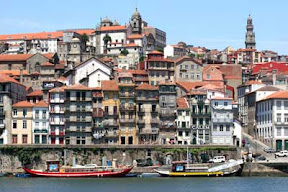Tripatini
the world's smartest travel social network
In Portugal, Port Wine is King
 |
| From NMT Images |
If Vasco do Gama, Magellan and Henry the Navigator fortified themselves with Port, Portugal’s most famous product, it might have made their journeys less horrific.
But Port wasn’t created until the 17th century, and today it’s undergoing a renaissance.
This easy-going, southern European country produced navigational giants that dominated the sea routes of the world, and controlled colonies as diverse as Brazil and Angola.
But what it controls today is perhaps more precious. According to international law, only Port produced in Portugal can be called “Port.”
And this sought after “liquid ruby” must come from one section and one section only of the land: the upper Douro Valley in the remote, north- east part of Portugal.
These are the demarcated Port vineyards of the world for this “Vinho de Vida,” wine of life.

| From NMT Images |
Porto itself is an elegant, old city, rich in Baroque cathedrals, winding, cobblestone streets, twisting alleys and huddled 17th century homes, still inhabited by the original families.
At night, Porto is more artfully lighted than Paris. The lighting scheme dramatically illuminates the old cornices and Rococo facades, and in the bright light of day, colorful bits of laundry wave in the breezes from the Douro River.
Sleek crafts slip silently along the river carrying oaken casks of Port on their open decks. Cafes line the river lifting silent toasts to the boatmen
At the various quintas (Port Wine estates) bare-footed groups of men and women crush the grapes in stone vats (lagares) accompanied by Portuguese musicians, and followed by a very happy celebration.
Primer on Port
Port is wine to which a “grape spirit” has been added to “fortify” it. Originally designed to protect the product during it’s long Atlantic sea voyage, the addition of the “grape spirit” also stops the fermentation process, allowing the Port to age without “turning,” resulting in a a full-bodied, rich beverage.
• Vintage Port (a premium at the liquor store) is aged in casks for two years, and further ages for between 10 and 50 years in the bottle Thus the price, and the delight. Vintage Port typically must be consumed within 3 days.
• Late Bottled Vintage (LBV) “rests” for 4-6 years in casks, is bottled and ready to drink. They don’t improve with age.
• Tawnys “rest” or age in casks between 10 and 40 years and are then bottled. However, the year of bottling for an authentic Tawny must be on the label as well as the vintage year.
The classic “pairing” for full-bodied Port is cheese: blue cheeses such as Stilton or Roquefort in particular, or with desert at the end of the meal. But truthfully, today’s Port aficionados are drinking it anytime and with whatever pleases them. Saude!
Comment
-
Comment by Kaleel Sakakeeny on October 26, 2010 at 1:42pm
-
Jose, here's to you and your superior knowledge about Port. I love it. I drink it, and very much appreciate the depth of your understanding.
Obrigado!
-
Comment by Kaleel Sakakeeny on October 26, 2010 at 1:40pm
-
Ed, Michael..thanks for your kind words! It was a fun piece to do and I'm glad you enjoyed it. Portugal's a wonderful country, diverse and softly lovely with none of the "overheated" cultural sense of Italy.
I hope you go, Michael. And, Ed, memories are what it's all about!
cheers
-
Comment by Jose R. Garrigo on October 26, 2010 at 1:14pm
-
I agree that, in Portugal, Port wine is king. But I would like to make a couple of coments to the gilven Port descriptions. Vintage Port, a Port of vintage that has been officially "declared" by the Port House (producer), does not necessarily have to be "consumed within three days" (I assume that K Sakakeeny meant three days after uncorking). Properly recorked and kept in a cool temperature it may last one or two weeks in the bottle although it slowly loses its grip. Vintage Port usually has to be decanted before drinking due to its usual amount of sediments. Tawnys neither "show the year of bottling nor a vintage year. They are a blend of different vintages according to the House Style. They only show 10, 20, 30 or (very rare) 40 Years Old Tawny on the label. By the way, the "grape spirit" is neutral brandy added to the wine to stop fermentation.
-
Comment by Ed Wetschler on October 26, 2010 at 1:07pm
-
An evocative blog, Kaleel. Not only have you made me think about past visits to Portugal, but I'm reminded of how, years ago, I made friends with a bartender in downtown Manhattan. The bartender regularly poured me glasses of vintage port from the fabled year of 1963 -- and it was on the house. Pretty glorious.
-
Comment by Michael Figueiredo on October 26, 2010 at 12:44pm
-
Very nice article! I have not been to Port yet, but it is definitely on my list of places to visit next time I go to Portugal. I love how you described how it is illuminated at night "more artfully" than Paris!
Videos
Groups
-
India
173 members
-
Tour Operators
873 members
-
Ireland
93 members
-
South Dakota
17 members
-
Azerbaijan
17 members
-
Shopping the World
55 members
-
Tech for Travel/Hospital…
87 members
-
Andorra
26 members
-
Online Corner
75 members
-
Minnesota
22 members
-
Backpackers & Hostels
84 members
-
Portugal
60 members
-
Turks and Caicos
26 members
-
Agritourism/Farmstays
72 members
-
Zambia
21 members
© 2025 Created by EnLinea Media.
Powered by
![]()
Badges | Report an Issue | Privacy Policy | Terms of Service
You need to be a member of Tripatini to add comments!
Join Tripatini